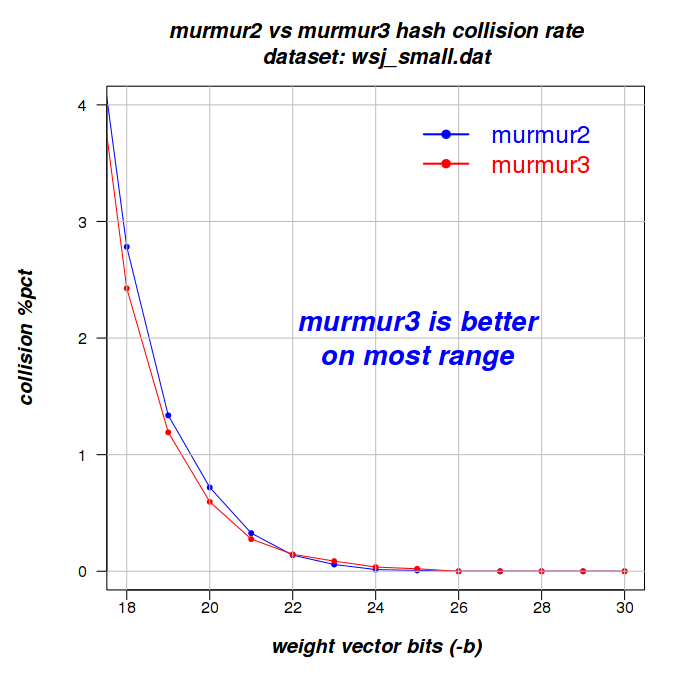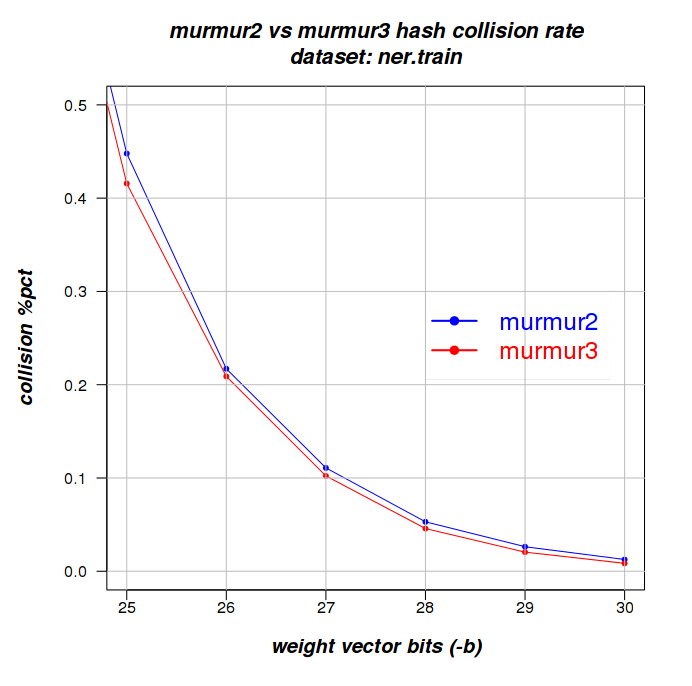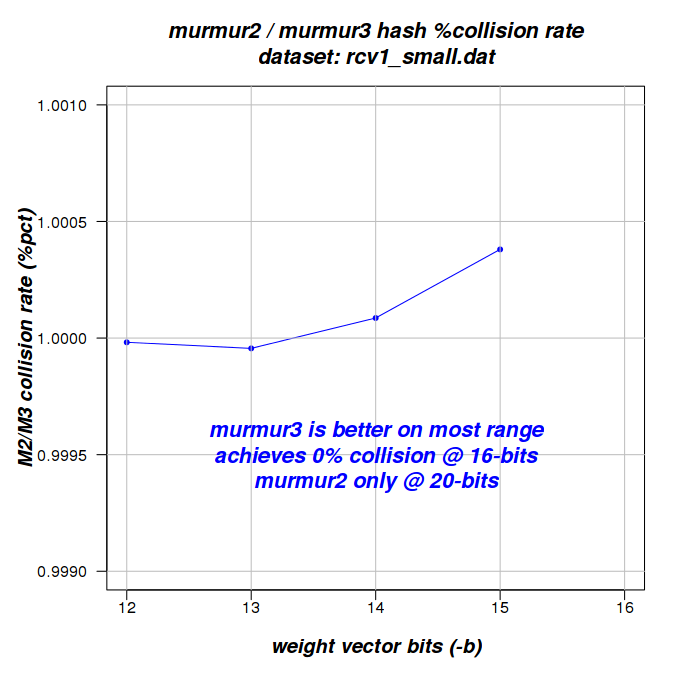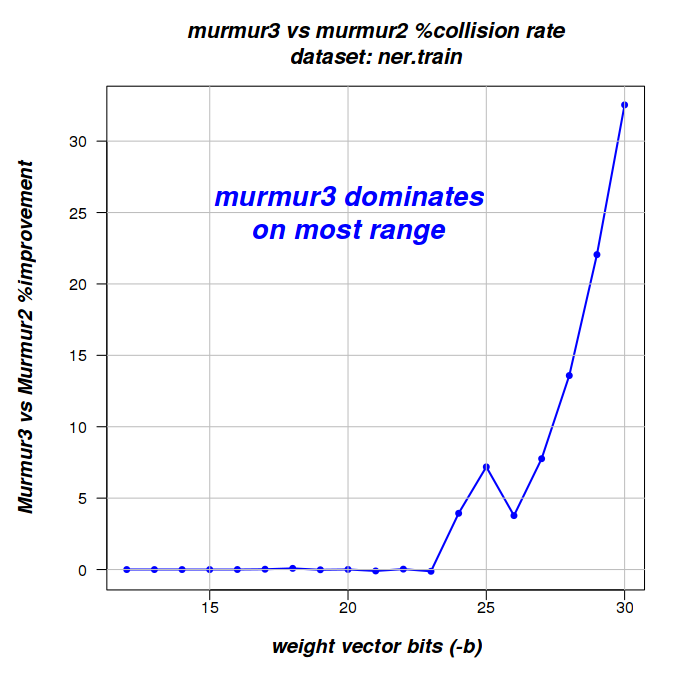-
Notifications
You must be signed in to change notification settings - Fork 1
murmur2 vs murmur3
I integrated Austin Appleby's murmur3 (the 32-bit version only) as a compile time (add -DMURMUR3 to FLAGS macro in Makefile) option to vw.
murmur3 brings a slight ~3% speed advantage in training time vs murmur2.
Update: after uprading to the latest version of murmur3 and running more extensive tests on bigger data-sets, I find that murmur3 is actually sllightly slower. Here are two examples:
Dataset newdev (not public):
M2: 12.512u 2.448s 0:07.94 188.2%
12.992u 2.628s 0:08.39 186.0%
12.608u 2.632s 0:08.11 187.7%
12.556u 2.668s 0:08.11 187.5%
12.632u 2.568s 0:08.10 187.5%
12.580u 2.520s 0:08.03 188.0%
12.660u 2.624s 0:08.21 186.1% Mean elapsed time: 8.127143 sec
M3: 12.824u 2.612s 0:08.23 187.4%
12.764u 2.852s 0:08.40 185.8%
12.888u 2.592s 0:08.32 185.9%
12.912u 2.624s 0:08.29 187.3%
12.736u 2.720s 0:08.25 187.2%
12.456u 2.892s 0:08.19 187.3%
13.052u 2.420s 0:08.27 187.0% Mean elapsed time 8.278571 sec (1.8632% slower)
Dataset: concatenate ner.train.gz 10 times:
M2: 19.493u 1.560s 0:14.92 141.0%
19.509u 1.520s 0:14.92 140.8%
19.553u 1.488s 0:14.92 140.9%
19.389u 1.824s 0:15.20 139.4% Mean elapsed time: 14:99 sec
M3: 19.757u 1.444s 0:15.12 140.1%
20.521u 1.388s 0:15.60 140.3%
20.301u 1.896s 0:15.84 140.0%
20.013u 1.696s 0:15.53 139.7% Mean elapsed time: 15.5225 sec (3.55% slower)
I used the data-sets in the test suite. Most data-sets don't have collisions with neither hash because -b 18 (the default) seems large enough to achieve hash sparsity.
In order to stress the hashing, I used --exact_adaptive_norm and varied the -b bits parameter from as low as 12 to induce collisions.
I found that on most data-sets I tried, once collisions are induced/forced, murmur3 had a slight advantage in hash collision avoidance.
One exception was 0002.dat where murmur2 achieves no-colisions @ -b 18 (the default) while murmur3 achieves no-collisions only at -b 21. The 2 colliding feature-names were short.
Feature Hash Value
T^BKF 10281
T^IWR 10281
T^DXJ 100053
T^GML 100053
Note: changing the seed value (hash_base constant in hash.h) from 97562527 to 0 avoids these 2 collisions. In the final commited version I switched to seed 0. Most of the results below are with seed 97562527.
A few data-sets have too few features to be interesting. They have zero collisions because too few fatures don't tend to collide. cs_test has 5 features, frank.dat has 3 features, seq_small has 7 features. These are not included in the table below. Also note that data-sets with unique numeric features don't collide unless they are hashed as strings regardless of them looking like integers (--hash all).
#-of-collisons
@ -b 18 (default) Winning hash method
DataSet #-features M2 M3 (dominates most -b 12..30 range)
0001.dat 4290 0 0 Murmur3
0002.dat 289 0 2 Murmur2
zero.dat 1032 0 0 same (also with --hash all)
wiki1K.dat 6330 0 0 same (also with --hash all)
rcv1_small.dat 23530 1 0 Murmur3
wsj_small.dat 13762 383 334 Murmur3
ner.train 292497 116204 116108 Murmur3
Having less collisions doesn't always lead to a smaller train average loss. I found some evidence among our test-suite examples that random collisions may sometime act as some kind of regularization and the surprising result is a lower average loss at the end.
Note, some charts have clipped X and/or Y ranges since otherwise the difference is too small to easily see. I did run all tests on all the 12 .. 30 bit range.
Also, not all charts have the same comparison criterion. Criterion was chosen to emphasize difference.



